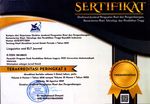An Analysis of Students' Ability in Distinguishing Lexical and Structural Ambiguity in English Sentences at Second Grade of SMA 1 Labuapi in the Academic Year 2016-2017
Abstract
Ambiguity is the property of having two or more distinct meanings or interpretations. Sometimes we found many ambiguities sentences when we are reading or listen to the English sentences. A word or sentence is ambiguous if it can be interpreted in more than one way. The problem stated in this study is: How is the students’ ability in distinguishing lexical and structural ambiguity in English sentences? The purpose of this study is to investigate the students’ ability in distinguishing lexical and structural ambiguity in English sentences at second grade of SMAN 1 Labuapi in academic year 2016/2017. This study used a descriptive qualitative approach. The writer used purposive sampling for taking the sample, namely class IPA 2 which consists of 22 students. The data were collected by a gap-filling test for lexical ambiguity word class of noun and label for structural ambiguity. The results of the research demonstrate that the students of SMAN 1 Labuapi were categorized into a very poor with the average score was 4.450. The writer illustrates the analysis result in the percentage of all test’s items in simple sentences, there were 890 ambiguous words and phrase. Lexical ambiguity involves noun (150) and structural ambiguity involve noun phrase (30). Finally, based on the research findings, the writer concluded that more than a half of students at the second grade of SMAN 1 Labuapi had very poor abilities in distinguishing lexical and structural ambiguity in English sentences.
Keywords
Full Text:
PDFReferences
Cruse, D. Alan. 2000. Meaning in language: An introduction to semantics and pragmatics. New York: Oxford University Press. 424 pages. (Review by Huttar 2001.)
Crystal, David 1980. A First Dictionary of Linguistic and Phonetic. Cambridge: University press.
Yule, George. 2006. The Study of Language: third edition: Cambridge University Press.
Djajasudarma, Fatimah. 1990. Semantik I: Pengantar ke Arah Ilmu Makna. Bandung: PT Refika Aditama
Purwaningsih Diah. 2014. An Analysis of Lexical and Structural Ambiguity Rubric Opini in Jawa Post. Unpublished Research Paper, Surabaya: University Surabaya.
Fromkin, Victoria, Rodman Robert, Hyams Nina,2006. An Introduction to Language. Nelson: University of California, Los Angeles.
Tambunan Andriani. 2009. The Analysis Of Lexical And Structural Ambiguity In Your Letter Jakarta Post. Unpublished Research Paper. University Of Sumatera Utara.
Hurford, James and Brendan Hesley.1983.Semantic: A Course Book. Cambridge: University press
Leech, Geoffrey 1981. Semantic the study of meaning. London: Penguin Books Longman (2nd edition, 2007)
Palmer, F, R.1976. Semantic: A New outline. London, Cambridge University Press.
Ullman, Stephen 1977. Semantics: An Introduction to the Science of Introduction. Oxford University Press.
Sugiono. (2014) Metode Penelitian Pendidikan (Pendekatan kuantitatif,kualitatif dan R&D), Bandung: CV. Alfabeta.
Yule, George. 1985. The Study of Language. Cambridge: Cambridge University Press
DOI: https://doi.org/10.31764/leltj.v9i1.733
Refbacks
- There are currently no refbacks.
Copyright (c) 2019 Linguistics and English Language Teaching Journal

This work is licensed under a Creative Commons Attribution-ShareAlike 4.0 International License.
_____________________________________________________
Linguistics and ELT Journal
p-ISSN 2339-2940 | e-ISSN 2614-8633

LELTJ is licensed under a Creative Commons Attribution-ShareAlike 4.0 International License.
_____________________________________________________
LELTJ is abstracting & indexing in the following databases:
_____________________________________________________
LELTJ Editorial Office:













